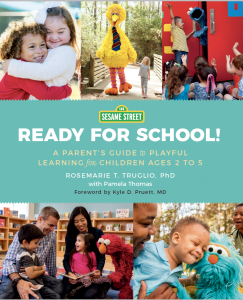With Sesame Street: Ready for School! A Parent’s Guide to Playful Learning for Children Ages 2 to 5, Dr. Rosemarie Truglio shares the research-based, curriculum-directed school readiness skills that have made Sesame Street the preeminent children’s television program for the past 50 years. The book features eight chapters on key areas of learning and child development, including language, literacy, math, science, logic & reasoning, social & emotional development, healthy habits, and the arts, and offers hands-on activities to help parents incorporate playful learning opportunities into their daily routines. The following is an excerpt on early STEM learning:Science Skills & the Scientific Process Through the lens of science—both natural science and physical science—children build on their understanding of the world. They learn how to adjust their ideas, as new experiences give them new information and more questions to investigate.
This ongoing pathway of discovery is part of the process called “scientific inquiry.” Early science skills include exploring, observing, asking questions, predicting, and testing ideas about how things work. Parents can help children develop their science knowledge and vocabulary simply by encouraging them to explore, ask questions, and talk about their discoveries. Most importantly, they learn to persevere and not to give up in the face of failure or setbacks.
Young children start to understand concepts related to the natural and physical world quite early, including living things, weather, force, and engineering. When these science topics are introduced through familiar, everyday experiences and in child-friendly language, young children can learn what might seem like complicated concepts. Children learn how to observe and ask questions. They develop their ability to collect and consider new information and draw conclusions about what they see.
Specifically, as children build their science skills, they start to:
Through the lens of science—both natural science and physical science—children build on their understanding of the world. They learn how to adjust their ideas, as new experiences give them new information and more questions to investigate.
This ongoing pathway of discovery is part of the process called “scientific inquiry.” Early science skills include exploring, observing, asking questions, predicting, and testing ideas about how things work. Parents can help children develop their science knowledge and vocabulary simply by encouraging them to explore, ask questions, and talk about their discoveries. Most importantly, they learn to persevere and not to give up in the face of failure or setbacks.
Young children start to understand concepts related to the natural and physical world quite early, including living things, weather, force, and engineering. When these science topics are introduced through familiar, everyday experiences and in child-friendly language, young children can learn what might seem like complicated concepts. Children learn how to observe and ask questions. They develop their ability to collect and consider new information and draw conclusions about what they see.
Specifically, as children build their science skills, they start to:

 Rosemarie T. Truglio, PhD, is the Senior Vice President of Curriculum and Content at Sesame Workshop. Dr. Truglio is responsible for the development of the interdisciplinary curriculum on which Sesame Street is based and oversees content development across platforms (e.g., television, publishing, toys, home video, and theme park activities). She also oversees the curriculum development for all new show production, including Esme & Roy, airing on HBO. Her current book is Ready for School! A Parent’s Guide to Playful Learning for Children Ages 2 to 5 published by Running Press (2019).
Rosemarie T. Truglio, PhD, is the Senior Vice President of Curriculum and Content at Sesame Workshop. Dr. Truglio is responsible for the development of the interdisciplinary curriculum on which Sesame Street is based and oversees content development across platforms (e.g., television, publishing, toys, home video, and theme park activities). She also oversees the curriculum development for all new show production, including Esme & Roy, airing on HBO. Her current book is Ready for School! A Parent’s Guide to Playful Learning for Children Ages 2 to 5 published by Running Press (2019).
 Through the lens of science—both natural science and physical science—children build on their understanding of the world. They learn how to adjust their ideas, as new experiences give them new information and more questions to investigate.
This ongoing pathway of discovery is part of the process called “scientific inquiry.” Early science skills include exploring, observing, asking questions, predicting, and testing ideas about how things work. Parents can help children develop their science knowledge and vocabulary simply by encouraging them to explore, ask questions, and talk about their discoveries. Most importantly, they learn to persevere and not to give up in the face of failure or setbacks.
Young children start to understand concepts related to the natural and physical world quite early, including living things, weather, force, and engineering. When these science topics are introduced through familiar, everyday experiences and in child-friendly language, young children can learn what might seem like complicated concepts. Children learn how to observe and ask questions. They develop their ability to collect and consider new information and draw conclusions about what they see.
Specifically, as children build their science skills, they start to:
Through the lens of science—both natural science and physical science—children build on their understanding of the world. They learn how to adjust their ideas, as new experiences give them new information and more questions to investigate.
This ongoing pathway of discovery is part of the process called “scientific inquiry.” Early science skills include exploring, observing, asking questions, predicting, and testing ideas about how things work. Parents can help children develop their science knowledge and vocabulary simply by encouraging them to explore, ask questions, and talk about their discoveries. Most importantly, they learn to persevere and not to give up in the face of failure or setbacks.
Young children start to understand concepts related to the natural and physical world quite early, including living things, weather, force, and engineering. When these science topics are introduced through familiar, everyday experiences and in child-friendly language, young children can learn what might seem like complicated concepts. Children learn how to observe and ask questions. They develop their ability to collect and consider new information and draw conclusions about what they see.
Specifically, as children build their science skills, they start to:
- Use all five senses to observe. They ask questions and gather new information through their eyes, ears, nose, mouth, and skin. Their senses help them identify the problem to solve. (“When my cup is in the sun, I see that the ice goes away and my water tastes warm. What happened to the ice?”
- Use simple tools to observe. They use tools (like a magnifying glass, a ruler, a scale, paper, and crayons), when needed, to help them investigate, see up close, measure, and record information.
- Make guesses and predictions. Children participate in simple experiments. They observe and use what they know from previous experiences to make a thoughtful guess about why something is happening (hypothesis). Then they make predictions and test their ideas (putting an ice cube in the sun and one in the shade to see which one melts more quickly).
- Collect and consider information to answer a question. Children learn to collect information (data) using simple charts, drawings, and photos. They learn how to organize the information so they can read it and draw conclusions. (For example, a child makes a simple chart with a drawing of a sun and a rain cloud and uses a check mark to record the weather each day for a month. From the number of check marks under the cloud, she concludes that it has been a rainy month.) During this process, children may learn that their initial ideas were wrong and will rethink their initial understanding or pose a new question.
- Share and explain conclusions. In time, children learn to report on what they’ve learned by describing a problem or question they investigated and explain what they discovered. To do this, children need to reflect and think about how and why things happened, based on their observations (“It happened because…”). This is an important milestone in cognitive reasoning. (Conclusion: She decides to keep her cup in the shade after discovering that the ice didn’t melt as fast there.)
A wonderful way to introduce even very young children to weather and the environment is to talk about the fascinating aspects of wind, especially with reference to the senses. Here are a few suggestions:

- We can see the wind when it creates ripples on a lake as it blows across, or musses our hair, or blows our hat off in an unexpected gust.
- We can hear the wind in the rustling of leaves through the trees, or when it unexpectedly blows the back door shut.
- We can feel the wind when a soft breeze caresses our cheeks, or as a strong wind makes it harder to ride a bike up a hill!
- We can smell the wind when it catches the scent of roses in a garden or hamburgers cooking on an outdoor grill, and blows the wonderful scents our way.
- Can we taste the wind? This is a tough thought! When talking about the wind, ask your child to come up with ways she can see, hear, touch, smell—and even taste the wind, and see what she comes up with!
 Rosemarie T. Truglio, PhD, is the Senior Vice President of Curriculum and Content at Sesame Workshop. Dr. Truglio is responsible for the development of the interdisciplinary curriculum on which Sesame Street is based and oversees content development across platforms (e.g., television, publishing, toys, home video, and theme park activities). She also oversees the curriculum development for all new show production, including Esme & Roy, airing on HBO. Her current book is Ready for School! A Parent’s Guide to Playful Learning for Children Ages 2 to 5 published by Running Press (2019).
Rosemarie T. Truglio, PhD, is the Senior Vice President of Curriculum and Content at Sesame Workshop. Dr. Truglio is responsible for the development of the interdisciplinary curriculum on which Sesame Street is based and oversees content development across platforms (e.g., television, publishing, toys, home video, and theme park activities). She also oversees the curriculum development for all new show production, including Esme & Roy, airing on HBO. Her current book is Ready for School! A Parent’s Guide to Playful Learning for Children Ages 2 to 5 published by Running Press (2019).